When it comes to good looks the wolfish must have been the last to arrive, but then beauty is always in the eye of the beholder. The rapidly increasing numbers of sea anglers travelling to Norway has seen the wolfish become almost a cult species and one many crave to catch now just as much as a 30lb cod.
I was scheduled to fish from Oksfjord working from the newly opened Oksfjord Sjofiske centre run by Brynjar and Gry Seljevold. I’d be fishing with Barney Wright, editor of Total Sea Fishing magazine and also Ian Peacock, the UK representative for Din Tur, the Norwegian fishing and adventure holiday company.
The local water encompass Oksfjorden, a deep fjord travelling inland some 26 kilometres and this in itself offers great fishing. Head right out of the harbour and you quickly reach a waterway crossroads. To the right and roughly east is Sternsundet Fjord with the island of Stjernoey in front of you. Head west and you reach more open sea with the island of Soeroey to the north and Silda to the west. It’s all prime fishing ground!
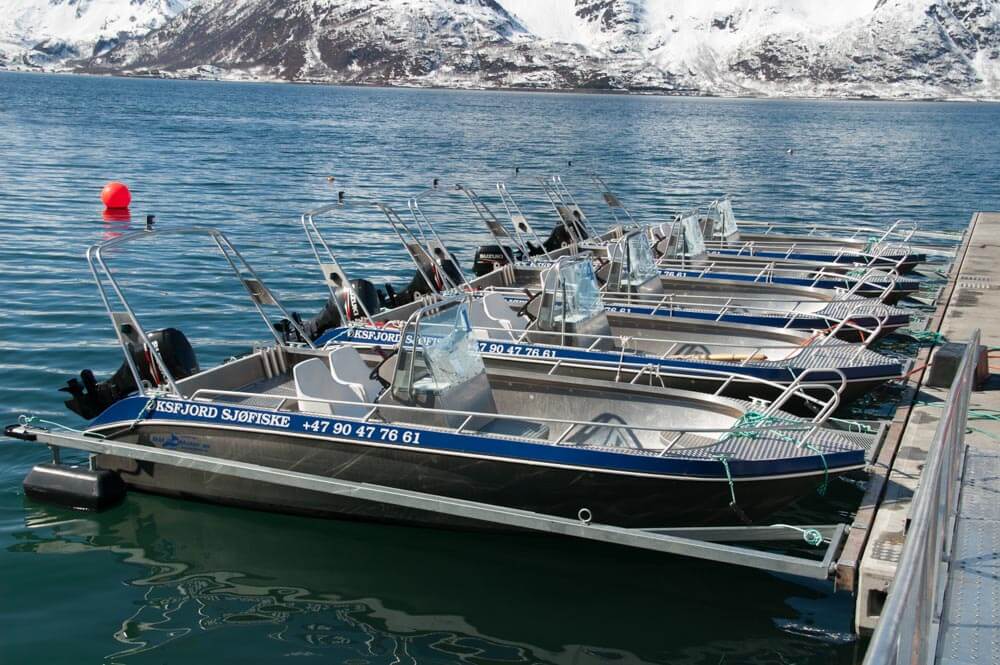
WOLFISH FACTS
Wolfish are true predators armed with a super strong hard skulled head and powerful jaws armed with sharp front teeth and gripping pads in the throat. These guys can take a chunk out of you without even thinking about it. You’ll often catch fish in these far northern waters with a fair percentage of their body mass missing courtesy of a wolf attack.
They have a thinly profiled but very muscular body designed to slide in and out of tight cracks in rocks which they use as ambush points to intercept passing prey. Also expect them over cleaner ground typically mud or more broken ground being happy to range far and wide when searching for food. Their colouring is slate grey with black vertical bands.
Adult fish prefer deeper water from 50-metres and deeper with the bigger fish tending to come from 100-metre depths, though this is a general rule but one I’ve noticed myself when fishing these Arctic Circle waters.
They feed on clams, scallops and crabs, but eat fish on the fin too, especially small cod, torsk and flatfish. They can grow to 25lbs plus in weight according to the ID books and scientific papers, though a specimen wolfish in modern times would be classed as 10lbs in weight.
Whilst fishing these Arctic seas you also have a chance of catching the spotted wolfish. These are similar in appearance to the common wolfish but their colouring is more a yellow brown and they carry distinctive dots on their fins, back and sides, also they grow bigger to an estimated 50lbs. They prefer deeper water to the common wolfish and are typically found in depths from 100 to 200-metres plus.
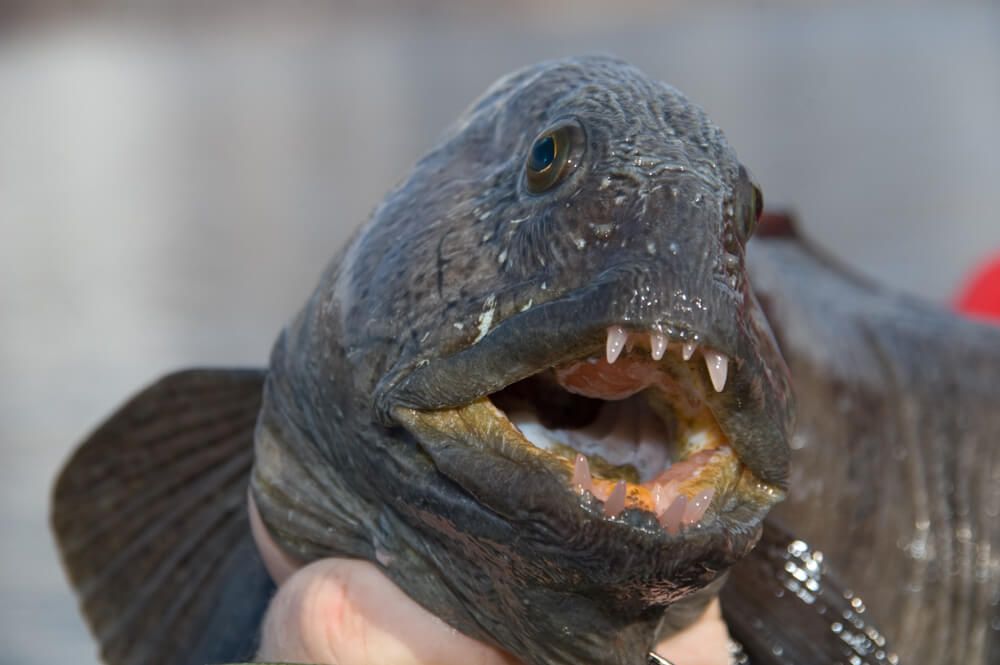
TACKLE FOR WOLFISH
There is no need to use heavy tackle off Oksfjord as the tide run in most areas is light, its more the speed of drift should it be windy that will dictate the tackle and lure weight to use, though you can find sheltered water easy enough anyway.
I use my own MTI 20/40 for pretty much all my conventional fishing in Norway, but any other 20/30 or 30lb class rod will do fine providing it has some stiffness in the butt to handle any bigger fish that come along, such as a halibut. The reel I prefer is the Penn TRQ100 loaded with 30lb braid and a 40lb shock leader. This has proved a top combination for me and has the power and versatility to handle a big halibut if one should happen along. Ian Peacock has also independently chosen the same outfit and he fishes in Norway a lot. Any comparable reel from the Shimano or Daiwa stables will do a great job too.
I like to tie in a strong Sakuma size 2/0 rolling swivel to the end of the shock leader, then tie on 50-inches of 100lb mono, tie on another 2/0 swivel, then add a Mustad 3/0 oval split ring to the base of the swivel to act as my connector link. These oval splits will not spring open on big fish and also can’t inadvertently release the lure when jigging. I don’t trust normal clip swivels of any type.
Wolfish will take normal pirks, especially if you bait them with a fillet of coalfish or cod, but I prefer to fish artificial lures for them and choose the outstanding Seawaver Giant Jigheads designed by German angler Volker Dapoz. You rig the jighead with an artificial shad and the whole lure comes alive in the water.
You can also ledger fish deadbaits on 200lb mono for wolfies, but I prefer the mobility of the lures and catch just as many fish.
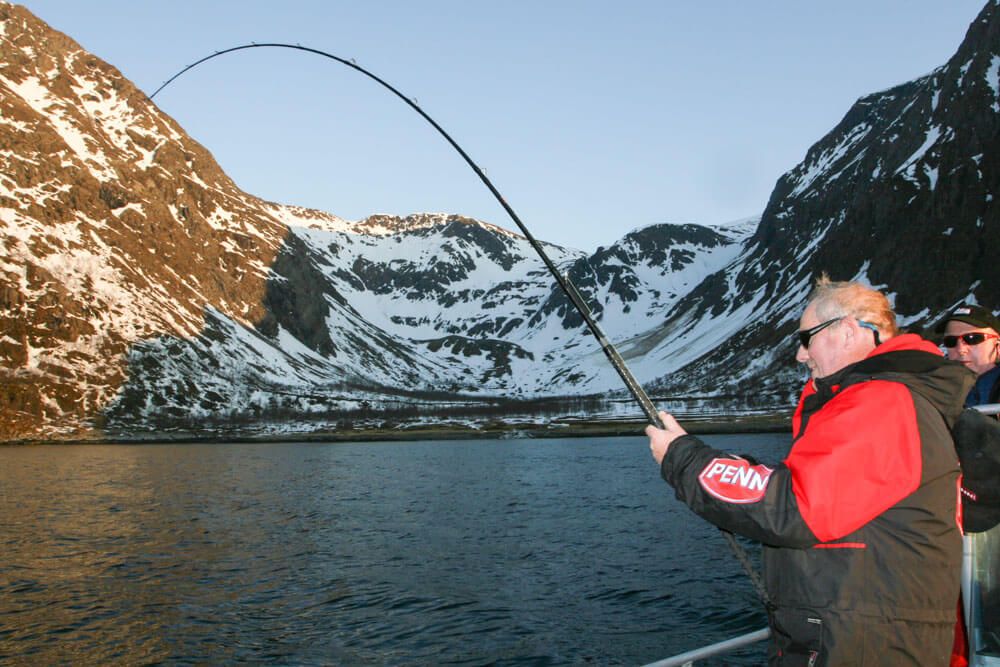
THE FISHING
This ground was all new to us and as we were one of the very first parties to come to the fishing centre there was little previous knowledge to work from. We identified a couple of good areas where we thought there might be better fish. The first one was just out from the point at Olanes on the opposite side of fjord where the depth dropped from 20-metres quickly in to 120-metres and keeps going.
I was fishing a 300gr Jighead with a white shad on. Ian and Barney were both fishing deadbaits as an alternative. It was easy to reach bottom though the drift quickened a little as we reached deeper water and this played in my favour as I was able to release a little line periodically keeping in touch with the seabed and searching the ground.
We caught some small cod and also torsk up to about 6lbs, but then something whacked my lure, shook its head and pulled the rod tip hard over. The fish fought well as wolfish don’t seem to suffer the bends on the way up. In mid water it hung for a few moments then took some line off before again holding. Steady pumping keeps the fish coming and gradually you could just make out a shade of white deep deep down in the ultra clear water.
The fish came up reluctantly to the last and still a little way underneath the surface Ian shouted “It’s a big wolf” and then I also saw the grey body and vicious looking head.
Barney hauling the fish aboard and it was certainly the biggest wolfish I’ve caught so far and bounced the scales down to a shade under 10lbs. Ugly to some maybe, but a cracking looking fish built by nature to do a specific job, a job is does extremely well!
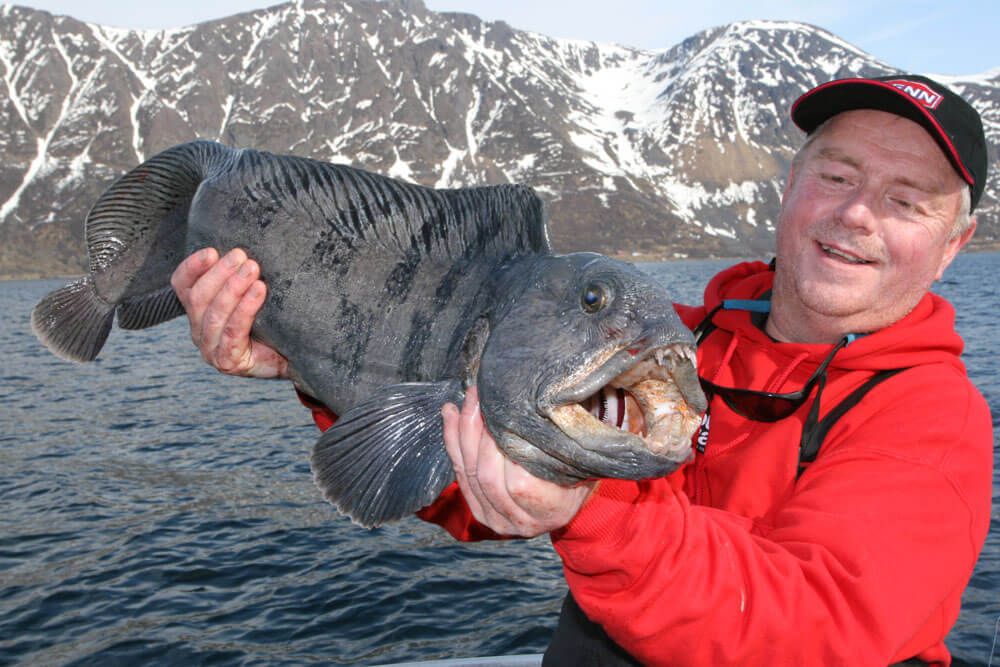
Within half an hour Barney got a fish on that he said felt “different” and he landed a smaller wolf about 4lbs.
Over the next few days we searched varied ground and caught a lot of wolfish to about 7lbs in amongst cod and torsk.
We decided to concentrate on some rising rock peaks just west of the Fjord mouth within Sternsundet Fjord. Heading east along the coast a half mile or so you come to a small island called, I think, Skarvskj. The drift for us was east to west and brings you over these ledges in a little less than 30-metres but dropping into 140-metres plus. It was when we left the drop offs and fished the 100-metre depth that we started hitting huge numbers of wolfish on both pirks and the Giant Jigheads.
I had several wolfish to 7lbs with Barney and Ian copying me fish for fish, then Ian’s rod curved over and took a powerful set indicating something a little more substantial had grabbed his lure. This again hung deep, took off a little line, hung deep again, then slowly, but very grudgingly surrendered depth up through the water column. We could see deep down it was good wolf and Ian took his time as they can hold on to the lure then suddenly let go at the last minute if you over pressurise them. This was well hooked and when it broke the surface it looked a good 9lbs plus. A slightly darker fish than mine, possibly due to living in amongst stone, but a truly impressive looking fish!
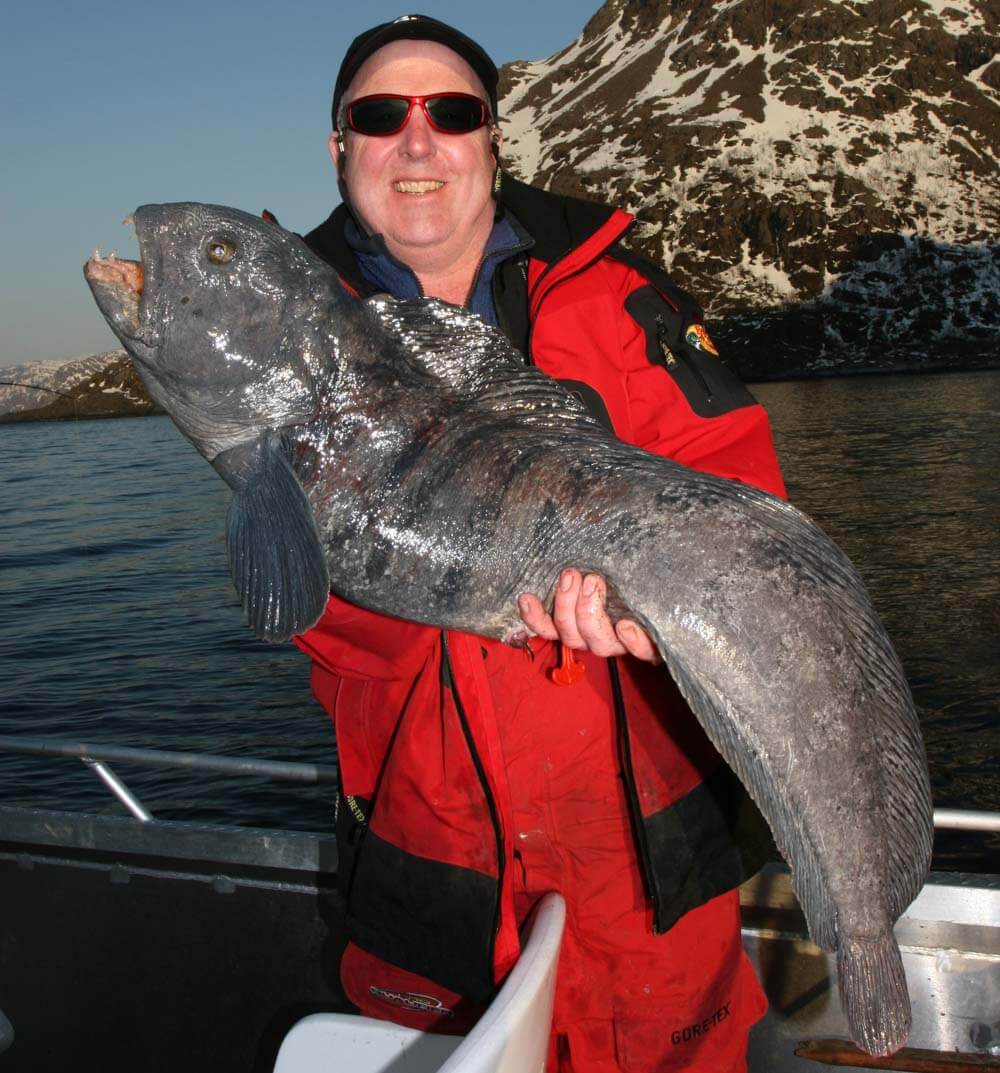
If you look at the western most tip of Stjernoey Island, just a short way out you’ll see some peaky ground called Karihomgr, Kavalgr and Eggegrund. These drop from roughly 25-metres down through 90-metres in to 180 metres plus. That junction line between 70-metres and 100-metres is good wolfish ground. We had a couple drifts here and with me fishing tighter to the seabed than the other lads (they were targeting halibut) I took six catfish in six drops which gives an indication of the numbers available if you get over the right ground.
For those of you looking to open your accounts with a wolfish, and hopefully bag a specimen, then by sheer numbers this ground out from Oksfjord gives you an excellent chance, and if you look on the charts for those 70 to 100-metre drop offs then that’s where you’ll find the lair of the bigger wolfish.
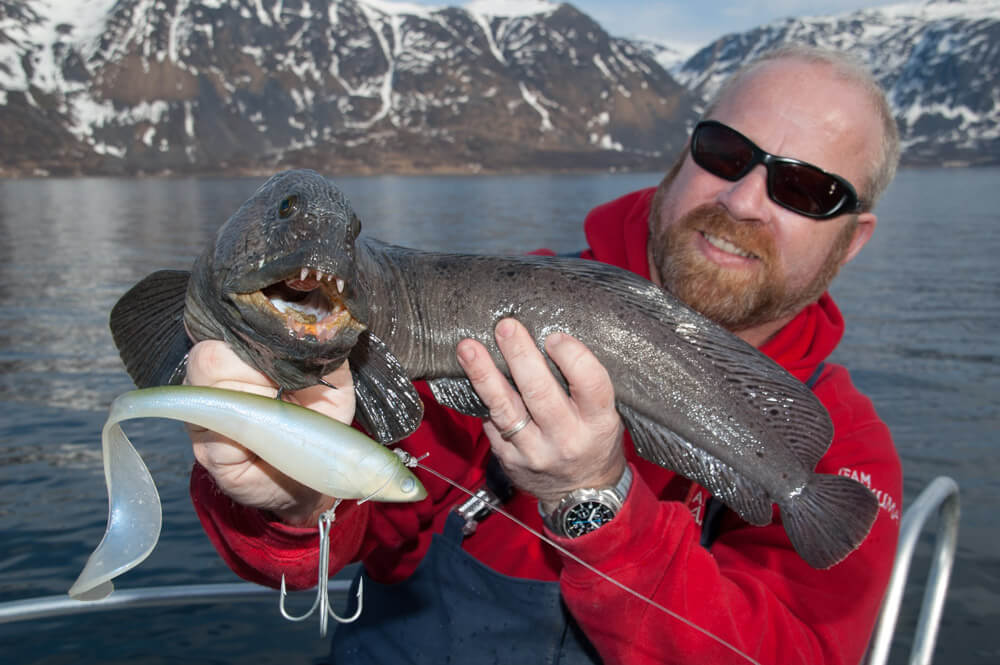
ACCOMMODATION, SERVICES & BOATS
We stayed at Oksfjord Sjofiske in the centre of Oksfjord. A new fishing centre for 2010 and one that’s already receiving rave reviews in Europe.
The accommodation currently comprises five separate apartments all sleeping six people and are beautifully decorated and exceptionally well equipped. There’s a storage and drying room in the basement for clothes and tackle, plus fish freezers.
The boats are 19ft aluminium boats, some twelve in number, capable of fishing three comfortably, powered by Suzuki 50hp outboards and fitted with Garmin 521S sounder/plotters. The boats are moored a short 3 minute walk away. Fuel is available just above where the boats are moored and can be paid for after working hours by credit card at the pump.
Adjacent to the apartments in a bar serving food and beer, just across the road is a supermarket carrying basic supplies with another good supermarket just down the road, also a bank with a cash machine. All the shops take common credit cards.
TRAVEL & BOOKINGS
We flew from Manchester to Oslo, then took an internal flight to Alta. The owners of the Oksfjord Sjofiske can organise pick up and transport for you from and returning to the airport to make things really easy. You can also fly from Edinburgh, London, Newcastle and numerous other local airports.
You can book to stay and fish on Oksfjord through Ian Peacock, Din Tur UK, Unit 1B, Cromwell Business Park, Hartlepool, TS24 7LR. Tel; 01429-866814. E-mail: peacock@dintur.co.uk Ian is highly experienced in organising Norwegian holiday’s for anglers and is an excellent angler himself, so he will answer any questions and sort out the best possible package for you.
I was scheduled to fish from Oksfjord working from the newly opened Oksfjord Sjofiske centre run by Brynjar and Gry Seljevold. I’d be fishing with Barney Wright, editor of Total Sea Fishing magazine and also Ian Peacock, the UK representative for Din Tur, the Norwegian fishing and adventure holiday company.
The local water encompass Oksfjorden, a deep fjord travelling inland some 26 kilometres and this in itself offers great fishing. Head right out of the harbour and you quickly reach a waterway crossroads. To the right and roughly east is Sternsundet Fjord with the island of Stjernoey in front of you. Head west and you reach more open sea with the island of Soeroey to the north and Silda to the west. It’s all prime fishing ground!

WOLFISH FACTS
Wolfish are true predators armed with a super strong hard skulled head and powerful jaws armed with sharp front teeth and gripping pads in the throat. These guys can take a chunk out of you without even thinking about it. You’ll often catch fish in these far northern waters with a fair percentage of their body mass missing courtesy of a wolf attack.
They have a thinly profiled but very muscular body designed to slide in and out of tight cracks in rocks which they use as ambush points to intercept passing prey. Also expect them over cleaner ground typically mud or more broken ground being happy to range far and wide when searching for food. Their colouring is slate grey with black vertical bands.
Adult fish prefer deeper water from 50-metres and deeper with the bigger fish tending to come from 100-metre depths, though this is a general rule but one I’ve noticed myself when fishing these Arctic Circle waters.
They feed on clams, scallops and crabs, but eat fish on the fin too, especially small cod, torsk and flatfish. They can grow to 25lbs plus in weight according to the ID books and scientific papers, though a specimen wolfish in modern times would be classed as 10lbs in weight.
Whilst fishing these Arctic seas you also have a chance of catching the spotted wolfish. These are similar in appearance to the common wolfish but their colouring is more a yellow brown and they carry distinctive dots on their fins, back and sides, also they grow bigger to an estimated 50lbs. They prefer deeper water to the common wolfish and are typically found in depths from 100 to 200-metres plus.

TACKLE FOR WOLFISH
There is no need to use heavy tackle off Oksfjord as the tide run in most areas is light, its more the speed of drift should it be windy that will dictate the tackle and lure weight to use, though you can find sheltered water easy enough anyway.
I use my own MTI 20/40 for pretty much all my conventional fishing in Norway, but any other 20/30 or 30lb class rod will do fine providing it has some stiffness in the butt to handle any bigger fish that come along, such as a halibut. The reel I prefer is the Penn TRQ100 loaded with 30lb braid and a 40lb shock leader. This has proved a top combination for me and has the power and versatility to handle a big halibut if one should happen along. Ian Peacock has also independently chosen the same outfit and he fishes in Norway a lot. Any comparable reel from the Shimano or Daiwa stables will do a great job too.
I like to tie in a strong Sakuma size 2/0 rolling swivel to the end of the shock leader, then tie on 50-inches of 100lb mono, tie on another 2/0 swivel, then add a Mustad 3/0 oval split ring to the base of the swivel to act as my connector link. These oval splits will not spring open on big fish and also can’t inadvertently release the lure when jigging. I don’t trust normal clip swivels of any type.
Wolfish will take normal pirks, especially if you bait them with a fillet of coalfish or cod, but I prefer to fish artificial lures for them and choose the outstanding Seawaver Giant Jigheads designed by German angler Volker Dapoz. You rig the jighead with an artificial shad and the whole lure comes alive in the water.
You can also ledger fish deadbaits on 200lb mono for wolfies, but I prefer the mobility of the lures and catch just as many fish.

THE FISHING
This ground was all new to us and as we were one of the very first parties to come to the fishing centre there was little previous knowledge to work from. We identified a couple of good areas where we thought there might be better fish. The first one was just out from the point at Olanes on the opposite side of fjord where the depth dropped from 20-metres quickly in to 120-metres and keeps going.
I was fishing a 300gr Jighead with a white shad on. Ian and Barney were both fishing deadbaits as an alternative. It was easy to reach bottom though the drift quickened a little as we reached deeper water and this played in my favour as I was able to release a little line periodically keeping in touch with the seabed and searching the ground.
We caught some small cod and also torsk up to about 6lbs, but then something whacked my lure, shook its head and pulled the rod tip hard over. The fish fought well as wolfish don’t seem to suffer the bends on the way up. In mid water it hung for a few moments then took some line off before again holding. Steady pumping keeps the fish coming and gradually you could just make out a shade of white deep deep down in the ultra clear water.
The fish came up reluctantly to the last and still a little way underneath the surface Ian shouted “It’s a big wolf” and then I also saw the grey body and vicious looking head.
Barney hauling the fish aboard and it was certainly the biggest wolfish I’ve caught so far and bounced the scales down to a shade under 10lbs. Ugly to some maybe, but a cracking looking fish built by nature to do a specific job, a job is does extremely well!

Within half an hour Barney got a fish on that he said felt “different” and he landed a smaller wolf about 4lbs.
Over the next few days we searched varied ground and caught a lot of wolfish to about 7lbs in amongst cod and torsk.
We decided to concentrate on some rising rock peaks just west of the Fjord mouth within Sternsundet Fjord. Heading east along the coast a half mile or so you come to a small island called, I think, Skarvskj. The drift for us was east to west and brings you over these ledges in a little less than 30-metres but dropping into 140-metres plus. It was when we left the drop offs and fished the 100-metre depth that we started hitting huge numbers of wolfish on both pirks and the Giant Jigheads.
I had several wolfish to 7lbs with Barney and Ian copying me fish for fish, then Ian’s rod curved over and took a powerful set indicating something a little more substantial had grabbed his lure. This again hung deep, took off a little line, hung deep again, then slowly, but very grudgingly surrendered depth up through the water column. We could see deep down it was good wolf and Ian took his time as they can hold on to the lure then suddenly let go at the last minute if you over pressurise them. This was well hooked and when it broke the surface it looked a good 9lbs plus. A slightly darker fish than mine, possibly due to living in amongst stone, but a truly impressive looking fish!

If you look at the western most tip of Stjernoey Island, just a short way out you’ll see some peaky ground called Karihomgr, Kavalgr and Eggegrund. These drop from roughly 25-metres down through 90-metres in to 180 metres plus. That junction line between 70-metres and 100-metres is good wolfish ground. We had a couple drifts here and with me fishing tighter to the seabed than the other lads (they were targeting halibut) I took six catfish in six drops which gives an indication of the numbers available if you get over the right ground.
For those of you looking to open your accounts with a wolfish, and hopefully bag a specimen, then by sheer numbers this ground out from Oksfjord gives you an excellent chance, and if you look on the charts for those 70 to 100-metre drop offs then that’s where you’ll find the lair of the bigger wolfish.

ACCOMMODATION, SERVICES & BOATS
We stayed at Oksfjord Sjofiske in the centre of Oksfjord. A new fishing centre for 2010 and one that’s already receiving rave reviews in Europe.
The accommodation currently comprises five separate apartments all sleeping six people and are beautifully decorated and exceptionally well equipped. There’s a storage and drying room in the basement for clothes and tackle, plus fish freezers.
The boats are 19ft aluminium boats, some twelve in number, capable of fishing three comfortably, powered by Suzuki 50hp outboards and fitted with Garmin 521S sounder/plotters. The boats are moored a short 3 minute walk away. Fuel is available just above where the boats are moored and can be paid for after working hours by credit card at the pump.
Adjacent to the apartments in a bar serving food and beer, just across the road is a supermarket carrying basic supplies with another good supermarket just down the road, also a bank with a cash machine. All the shops take common credit cards.
TRAVEL & BOOKINGS
We flew from Manchester to Oslo, then took an internal flight to Alta. The owners of the Oksfjord Sjofiske can organise pick up and transport for you from and returning to the airport to make things really easy. You can also fly from Edinburgh, London, Newcastle and numerous other local airports.
You can book to stay and fish on Oksfjord through Ian Peacock, Din Tur UK, Unit 1B, Cromwell Business Park, Hartlepool, TS24 7LR. Tel; 01429-866814. E-mail: peacock@dintur.co.uk Ian is highly experienced in organising Norwegian holiday’s for anglers and is an excellent angler himself, so he will answer any questions and sort out the best possible package for you.

